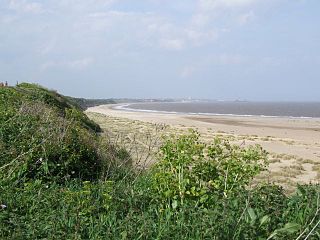
Kessingland is a village and civil parish in the East Suffolk district of the English county of Suffolk. It is located around 4 miles (6 km) south of Lowestoft on the east coast of the United Kingdom. It is of interest to archaeologists as Palaeolithic and Neolithic implements have been found here; the remains of an ancient forest lie buried on the seabed.

Lowestoft is a coastal town and civil parish in the East Suffolk district of Suffolk, England. As the most easterly UK settlement, it is 110 miles (177 km) north-east of London, 38 miles (61 km) north-east of Ipswich and 22 miles (35 km) south-east of Norwich, and the main town in its district. The estimated population in the built-up area exceeds 70,000. Its development grew with the fishing industry and as a seaside resort with wide sandy beaches. As fishing declined, oil and gas exploitation in the North Sea in the 1960s took over. While these too have declined, Lowestoft is becoming a regional centre of the renewable energy industry.

St Anthony's Lighthouse is the lighthouse at St Anthony Head, on the eastern side of the entrance to Falmouth harbour, Cornwall, UK. The harbour is also known as Carrick Roads and is one of the largest natural harbours in the world.

Royal Sovereign lighthouse is a decommissioned lighthouse marking the Royal Sovereign shoal, a sandbank 11 km (6.8 mi) offshore from Eastbourne. The structure's distinctive shape is easily recognised as the lighthouse tower is perched above a large platform supported by a single pillar rising out of the water. Originally, the platform was manned by three full-time keepers, accommodation being contained in the 'cabin section' immediately below the platform. Additional accommodation was provided for up to four visiting maintenance workers.

Cromer Lighthouse is situated in the coastal town of Cromer, in the English county of Norfolk.
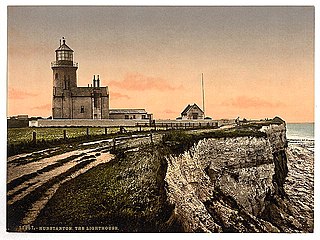
Old Hunstanton Lighthouse is a former lighthouse located in Old Hunstanton in the English county of Norfolk, generally called Hunstanton Lighthouse during its operational life. It was built at the highest point available on this part of the coast, on top of Hunstanton Cliffs, and served to help guide vessels into the safe water of Lynn Deeps. Although the present lighthouse was built in 1840, there had been a lighthouse on the site since the 17th century. Prior to the establishment of the Lynn Well light vessel in 1828, Hunstanton Lighthouse provided the only visible guide to ships seeking to enter The Wash at night.

Gorleston South Pier Lighthouse and Coastwatch watch station is located in the town of Gorleston in the English county of Norfolk. The lighthouse and station is located at the end of the south pier of seaport on the south side of Great Yarmouth.

Pakefield is a suburb of the town of Lowestoft, in the East Suffolk district, in the north of the English county of Suffolk. It is located around 2 miles (3.2 km) south of the centre of the town. It 2011 the ward had a population of 6,563.

Hurst Point Lighthouse is located at Hurst Point in the English county of Hampshire, and guides vessels through the western approaches to the Solent.
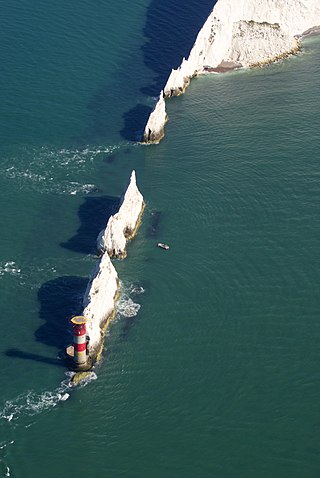
The Needles Lighthouse is an active 19th century lighthouse on the outermost of the chalk rocks at The Needles on the Isle of Wight in the United Kingdom, near sea level. Designed by James Walker, for Trinity House at a cost of £20,000. It was completed in 1859 from granite blocks, stands 33.25 metres (109.1 ft) high and is a circular tower with straight sides. It replaced an earlier light tower on top of a cliff overhanging Scratchell's Bay, which was first lit on 29 September 1786.
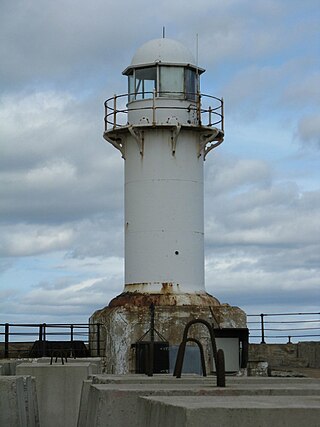
South Gare Lighthouse was built in 1884 at the end of the breakwater at South Gare north west of Redcar in North Yorkshire and in north eastern England.

Whitby Lighthouse is a lighthouse operated by Trinity House. It is on Ling Hill, on the coast to the south-east of Whitby, beyond Saltwick Bay. To distinguish it from the two lighthouses in Whitby itself it is sometimes known as Whitby High lighthouse

The Old Higher Lighthouse is a disused 19th century lighthouse on the Isle of Portland, Dorset, southern England. It is located at Branscombe Hill on the west side of Portland, overlooking Portland Bill. The lighthouse is Grade II Listed.

The Old Lower Lighthouse is a disused 19th century lighthouse on the Isle of Portland, Dorset, southern England. It is located along the eastern side of Portland Bill. The lighthouse, including its boundary walls and coastguard house, became Grade II Listed in September 1978.

The Portland Breakwater Lighthouse is a functioning lighthouse located at Portland Harbour, Isle of Portland, Dorset, England. It is situated on the southern end of the north-east breakwater.

Lowestoft Lighthouse is a lighthouse operated by Trinity House located to the north of the centre of Lowestoft in the English county of Suffolk. It stands on the North Sea coast close to Ness Point, the most easterly point in the United Kingdom. It acts as a warning light for shipping passing along the east coast and is the most easterly lighthouse in the UK.

St Catherine's Lighthouse is a lighthouse located at St Catherine's Point at the southern tip of the Isle of Wight. It is one of the oldest lighthouse locations in Great Britain.

Dungeness Lighthouse on the Dungeness Headland started operation on 20 November 1961. Its construction was prompted by the building of Dungeness nuclear power station, which obscured the light of its predecessor which, though decommissioned, remains standing. The new lighthouse is constructed of precast concrete rings; its pattern of black and white bands is impregnated into the concrete. It remains in use today, monitored and controlled from the Trinity House Operations and Planning Centre at Harwich, Essex.

Orfordness Lighthouse was a lighthouse on Orford Ness, in Suffolk, England. The 30 metres (98 ft) tower was completed in 1792. Work began on demolition in July 2020, and was completed in August. The light had a range of 25 nautical miles. It was equipped with an AIS transmitter with MMSI 992351016.
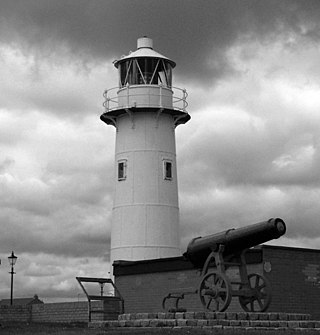
The Heugh Lighthouse is a navigation light on The Headland in Hartlepool, in north-east England. The current lighthouse dates from 1927; it is owned and operated by PD Ports. It is claimed that its early-Victorian predecessor was the first lighthouse in the world reliably lit by gas.






















